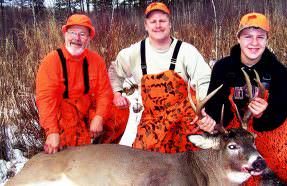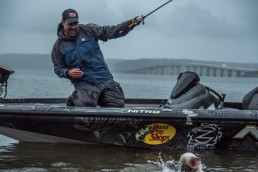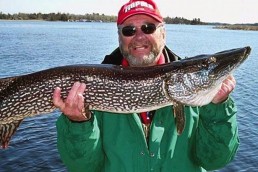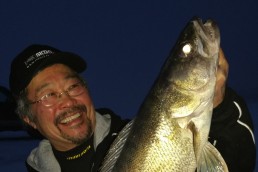in his own words… Dr. Ken Nordberg: Teeth, Tracks and Tines
SHARE THIS POST
You can’t say that Dr. Ken Nordberg’s life’s work is wrapped up in understanding whitetail deer, because that would ignore his contributions to kidney research, and our knowledge of what keeps children from getting cavities, and his years as a practicing dentist. Besides, there’s the study of black bears, hunting habits of wolves, and more.
His hunting-centric studies focus on what it takes to create close-range shots at mature whitetail bucks that are relaxed and basically standing in front of the gun or bow. He and his family have long hunted on public land in extreme northern Minnesota, in an area of low deer densities and healthy wolf numbers. Yet, consistently, he, his children, and now grandchildren are photographed proudly kneeling behind good bucks, taken under challenging conditions.
If you’re a longtime MidWest Outdoors reader, you know this man, his passions, and his knowledge. You probably also know his nine-volume (soon to be 10) series of Whitetail Hunter’s Almanacs, and Do-it-yourself Bear Baiting & Hunting series.
Dr. Nordberg does not work for a state or federal wildlife agency, but before you dismiss his work as that of an unqualified layman, consider that he has a B.A. degree in Experimental Animal Psychology, along with a B.S. degree in Natural Sciences, emphasis in wildlife biology, both from the University of Minnesota. (This in addition to a Dental Degree.)
Consider, too, that he possesses a knack for tackling multiple challenges at the same time. As he entered dental school at the University of Minnesota in 1957, he also signed on as a senior lab technician working on kidney research in the university’s Physiology department, something he continued until being graduated from dental school.
“That,” Nordberg says, “is where I started to learn how to do research.”
It’s a long story and we cover it in the timeline, but after starting a dental practice in Aitken County, Minnesota, Dr. Nordberg was called to active duty in the Navy and served almost three years on a ship as the floating dentist. His fledgling practice had to be shut down.
After mustering out of the Navy in 1967, he began a second dental practice, from scratch, in the Minneapolis area. At the same time, he taught Pediatric Dentistry at the University of Minnesota, while simultaneously heading up research into why some children get a lot of cavities and others almost none. All told, he led this research project for almost seven years, giving him deep immersion in the scientific process.
“By the time I got to that point,” says Nordberg, “you couldn’t be better trained for studying habits and behavior of wildlife in the wild.”
While traditional research into wild animals does not focus on helping hunters, enhancing hunting success is the premise behind everything “Doc” has done in this area.
What he has to say is compelling to hunters.
And so we present Dr. Ken Nordberg, in his own words…
MidWest Outdoors: You started your research on whitetail deer behavior in 1970. What was the first thing you studied?
Dr. Ken Nordberg: One of the first things I set out to study, using scientific methods, was to look into why we had so many spike bucks in the area we hunted in Aitken County. We set up a study area and started providing cattle-type mineral blocks to the deer in a two-square-mile area, and not to the deer in another two-square mile area.
Before long, after a few years, we found that not only did we rarely have a spike buck in the treated area, but we also had better fawn survival, compared to the untreated area. What it meant was that our deer were not getting enough calcium, phosphorous, zinc, and other minerals it takes to create the bony antlers. They weren’t getting enough of these things to create as large a set of antlers as they were capable of growing.
After these deer started getting mineral blocks, we had 8-pointers as yearlings. Little basket-type antlers, but what a difference it made. Back then, they were saying, “it’s good to shoot all the spikes; get them out of the population, it’s a genetic deficiency.” Those bucks were as good as all the other bucks; they just didn’t get enough of these important minerals.
So here was a change in thinking, and there have been a lot of other changes. Our whitetails were different than what people believed, when you start going at it in a scientific manner.
MWO: Another thing deer hunters will find fascinating is that, by observing how wolves hunt, you have modified the way you move through the woods while walking to and from your stand locations. Tell us about that.
Nordberg: One of the things we learned from wolves is that when they’re close to deer, they don’t want those deer to be thinking that they’re in danger. Wolves will march past deer without stopping, slowing down, or speeding up. Just a nice pace, keeping their heads pointed straight ahead until they’re past the deer and disappear out of sight.
If they’ve selected one of the deer as prey, they’ll come back and set up a trap. The Alpha male or female comes sneaking back, crosswind, and the rest of the wolves circle around and get downwind, which they can do because they can smell ‘em. Then they wait for the deer. And I’ve been caught real close to those downwind locations on quite a few occasions.
Here comes a deer running lickety-split and a wolf about 30 feet behind it going lickety-split, and these downwind wolves spread out and they get the deer. A few times I’ve ruined it for them and the deer was able to veer to the side and finally get away from those downwind wolves. The wolves don’t have a chance then. They’ll join the chase, but a healthy adult whitetail can outrun a wolf every time. And they can jump over things that wolves can’t jump over. But this method works for wolves, and they do it to moose as well, especially young moose. I almost got run down by a moose at a point where the wolves had just started to chase it.
Wolves do this all the time, and it has become part of our newest way of hunting whitetails, and it’s really kind of neat.
(Note: Dr. Nordberg explains exactly how he and his family use the wolf technique while hunting, in the podcast episode.)
MWO: Take us back to your roots in the outdoors, as a youngster. What are your earliest memories that led to your passion for hunting?
Nordberg: My father was in the Second World War, as a shore patrolman, stationed at Treasure Island in San Francisco Bay. After he got out of the service, we came back to Minnesota, and he was looking for a job, and jobs were hard to find at that point. We went back and lived up north at the farm, where he grew up, with my grandparents.
From that time on, I spent most of my summers there until I was about 15 years old, helping with farm chores and that kind of thing. The first winter, I wanted to earn money to buy things, so I started trapping weasels. I had cousins that trapped them too, and we made some money. We would get anywhere from 35 cents to $1.35 for a hide.
Are you enjoying this post?
You can be among the first to get the latest info on where to go, what to use and how to use it!
I had a trapline that went along an old logging road that went out into the woods. Out and back was five miles. I got to be good at trapping, and I saw deer all the time, and their tracks, and back then I was really curious about what deer did. I’d follow their tracks in the snow.
MWO: So you were doing this all by yourself? How old were you?
Nordberg: Yes, all by myself, at 10 years old. I was so curious about deer, and wanted to know what they did. I finally earned enough money that I bought my first rifle with my weasel money. It cost me about 35 dollars, at a Gambles hardware store, a Model 94 Winchester.
That fall was my first year to hunt, and on opening day we went out, and it was a family type thing, all the neighbors were there, uncles and cousins, and we made drives everywhere. Just kept making drives. All the deer I ever saw were just running like crazy.
The first one I ever saw, while hunting, was a doe that was running ahead of the drivers. I had just come up to my uncle Jack, and the doe ran right by me. And Jack turned to me and asked, “How come you didn’t shoot?” And I said, “I was just thinking about how pretty it was, it was so graceful,” and my thoughts kind of trailed off.
Well, an hour later I had three cousins giggling about Kenny having a terrible case of buck fever, how I froze up when the deer came by and didn’t even think about shooting. All that night I heard buck fever and giggling, and the next morning we went out and I heard buck fever and giggling the whole way out there. We made our first drive that morning, and it was almost at the end of the drive when I heard my father talking. He was one of the standers, not too far from me

All of a sudden, four deer ran right out in front of me and stood in this little opening. We were party hunting, so you could shoot more than one deer, and I got my gun up and shot three of them. The fourth one was a big buck, and when it came by I took aim––it was really close––and fired, and the gun went ‘click.’ I was out of bullets.
Well, from that day on, I never heard any giggling or the words buck fever. I made a name for myself right away, at age 10. Back then, they closed the school during deer season because all the boys, and some of the girls, would be hunting. We come back to school that year, and everybody’s talking about deer hunting, and I heard, “he got three…” and I guess that kind of set the stage for wanting to be a really good deer hunter.
We did that for 15 years, making all those drives. And in all those years, we only got one big buck. All the rest were antlerless deer or yearling bucks. That really disappointed me. I wanted to hunt big bucks. I wasn’t a good shot on running deer, either, so I thought, “there’s got to be a better way to hunt.”
MWO: As the wheels began turning in young Ken Nordberg’s mind, years before stitching together college degrees and research experience, the beginnings of the Nordberg mature buck hunting style had its roots.
Nordberg through the years
July 10, 1935: Born, in Grand Rapids, Minn.
1945: Began hunting whitetail deer seriously, at 10 years old. Shot three deer his first season.
1953: Graduated from Anoka High School in the Twin Cities area.
1957: Graduated from University of Minnesota with B.A. degree in Experimental Animal Psychology. His college advisor, “kept shaking his head,” says Nordberg. “What do you ever plan to do with this? I wasn’t sure, but I enjoyed it, and knew I was going to try to use it someday, somehow.”
1957: Began work as a senior lab technician in University of Minnesota Physiology department, doing kidney research, while also starting dental school and taking courses toward a B.S. degree in Natural Sciences. He continued working on the kidney research during all years of dental school. “I was really learning how to do research,” Nordberg notes.
1959: Earned B.S. degree from University of Minnesota in Natural Sciences, emphasis on wildlife biology.
1961: Earned D.D.S. degree from University of Minnesota School of Dentistry.
1964: Having started a dental practice in Aitken County, Minnesota, Nordberg is called up for active duty by the U.S. Naval dental clinic in Norfolk, Virginia. Served on the USS Vulcan (AR-5), a Navy ship, for nearly three years.
1967: After Navy duty, began a new dental practice in Northeast Minneapolis. During the early years of his practice, Dr. Nordberg also taught Pediatric Dentistry at University of Minnesota Dental School. During this same period, he also headed research into why some children were getting a lot of cavities and others almost none. He led this research for 6 1/2 years. “By the time I got to that point,” says Nordberg, “you couldn’t be better trained for studying habits and behavior of wildlife in the wild.”
1970: Began seriously studying the habits of whitetail deer, leading to his books and other teachings.
1985–2005: Conducted Buck Hunting School, starting at Anoka-Hennepin schools. In 1996, the workshops moved to Laurentian Environmental Center near Britt, in northern Minnesota. They became two days in the field, two days in the classroom. Video recordings of the school are still available, in a 10-disc DVD collection.
1996–2005: Conducted Bear Hunting School, also at Laurentian Environmental Center. Video recordings of the school are available in a 2-disc DVD set.
1990: Published first edition of Do-it-yourself Black Bear Baiting & Hunting. Later editions were published in 2001 and 2014.
MWO
SHARE THIS POST
Did you enjoy this post?
You can be among the first to get the latest info on where to go, what to use and how to use it!
Mark Strand
MidWest Outdoors editorial director Mark Strand is a graduate of University of Minnesota School of Journalism with a minor in Fisheries & Wildlife Science. He has written for nearly every outdoor magazine over the past 41 years, and has written or co-written 14 books. In addition to writing and photography, Strand produces the MidWest Outdoors Podcast, and contributes to MWO digital properties. He is an outdoor generalist who loves hunting and fishing of all types. In 2018 Strand was elected to the Minnesota Fishing Hall of Fame.



